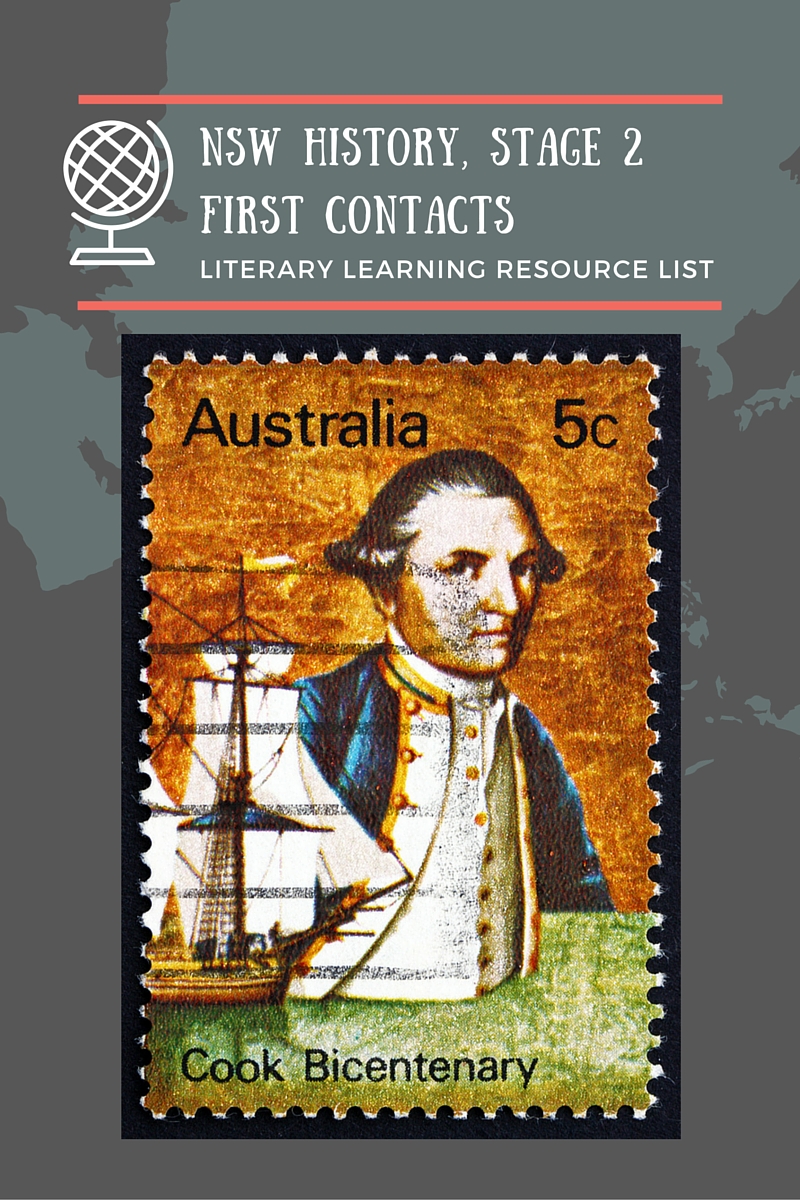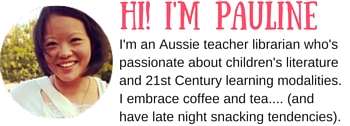Infusing literary learning into the History curriculum enhances student understanding; students are endowed with narratives to connect abstract historical content to their everyday lives. When infusing literary learning into the History curriculum, literary texts should first be read with an aesthetic emphasis. Any consequent discussions of efferent (skills/content) elements should be prefaced with the author’s use of verified historical sources.
The NSW History Stage 2 First Contacts content (Board of Studies NSW, 2012) requires students be introduced to world history and the movement of peoples. Historical concepts of continuity and change, cause and effect, perspectives, empathy and significance are themes abundant in literature. Literary learning can be used to explore what life was like for Aboriginal and Torres Strait Islander (ATSI) peoples before the arrival of the Europeans; why the great journeys of explorations occurred; why Europeans settled in Australia; and the nature and consequence of contact between ATSI peoples and early explorers and settlers. Through literary learning, students can engage with the ATSI peoples Histories and Cultures cross-curriculum priority (Australian Curriculum Assessment and Reporting Authority, 2015) embedded throughout the First Contacts content – i.e. the rich history and diversity of ATSI cultures (the oldest continuing cultures on the planet), the special connection of people to Country and Country to people, and the strong and sophisticated family and kinship structures of the ATSI peoples.
Literary learning resource list: Stage 2 History, First Contacts
Balla, T. (2014). Rivertime. Crows Nest, NSW: Allen & Unwin.
Rivertime is a graphic novel recount of a 10.5-year-old boy, Clancy’s transformative ten-day camping trip along the Glenelg River with his uncle. The setting of this literary non-fiction narrative transports readers along parts of the remote traditional home of the Gundjitmara and Boandik peoples, filled with natural beauty; instilling an empathetic understanding of the land, creatures and First Australians who have been there for more than 50,000 years. Sprinkled with labelled drawings of bush creatures, the calm gentle coloured pages of the book creates a meditative atmosphere as it explores continuity and change, and beckons readers to grow alongside Clancy in his awakened appreciation of peace and tranquillity in the natural world.
Butler, M., & Dean, B. (Directors/Producers/Writers). (2013). First footprints [Interactive documentary]. NSW: Australian Broadcasting Corporation. Retrieved from http://www.abc.net.au/tv/firstfootprints/
An interactive documentary that uniquely explores 50,000 years of Australia’s ancient past through the world’s oldest oral stories, new discoveries, stunning art, cinematic computer generated graphics and film, First footprints presents four episodes, each spanning varying historical periods of over 10,000 years. As a whole, the non-linear hypertext and multimedia narrative tells of humanity’s original pioneers, the First Australians and their: epic long distance migration from Africa; survival through the last ice age and global warming great floods; and their sustainable transformation of an entire continent. This digital resource, with its blending of personal stories, artefacts and interactive features connects readers to relatable multiple investigative sources, developing varying historical perspectives alongside an empathetic understanding of Australia’s first peoples.
French, J. (2006). The goat who sailed the world. Pymble, NSW: HarperCollins.
Illuminating the historical events of Captain Cook’s first voyage on the Endeavour to Australia, the first Animal Stars series novel, The Goat who Sailed the World, is a mix of fact with fiction. It is told from the alternating fictional viewpoints of two true historical characters on board the Endeavour- the goat who travelled on two Pacific voyages and Isaac a twelve year old boy who later becomes a high ranking naval officer. The carefully researched historical characters and context are brought together with fictional narrations and their engaging point of views, stirring readers to reconsider historical events, and themes of significance, and cause and effect from new untold perspectives.
French, J. (2012). Dingo: The dog who conquered a continent. Sydney, NSW: HarperCollins.
Set about five to ten thousand years ago when the first dingo arrived in Australia, this valuable resource binds together historical concepts of continuity and change, cause and effect, perspectives, empathetic understanding and significance. Dingo: The dog who conquered a continent is a fast pace historical fiction of survival and friendship in wild new land, is told from two alternating viewpoints, characteristic of the Animal Stars series. Loa, a young man proving his worth, and The Dog, Australia’s first dingo, restores details of the environment and everyday life Australia’s ancient inhabitants faced. Connections to the land are clear; the Country provides all that is needed for survival. The need for and place of kinship structures are also explored as Lao journeys to maturity.
Giannone, R., & Emmerichs, B. (Illustrator). (2013). What’s your story? Kew East, Victoria: Berbay.
The historical fiction picture book What’s Your Story, with its uniquely intricate and stylised illustrations visually depicts the First Fleet’s Sydney settlement. Cause and effect are considered in the telling of the First Fleet’s journey to Australia. The narrative then follows Leonard, a young English orphan, in his topsy-turvy new home, where everything looks, feels and sounds different. Leonard befriends Milba, an Eora girl, and together they discover each other’s worlds through a gentle orientation of cultures. Through the friendship, readers are prompted to empathetically consider stories of the First Fleet and the nature of contact between the First Australians and the Europeans, through multiple perspectives.
**Read more – What’s your story Book Rap literature response strategy.
Murdie, R. & Nixon, C. (Illustrator). (2013). Meet Captain Cook. North Sydney, NSW: Random House Australia.
Meet Captain Cook, a literary non-fiction picture book, is an engaging introduction to Captain Cook and his first voyage to Australia. The interplay of stunning illustrations and narrative prose provide scope for imaginative interpretations, increasing affective personal responses to historical facts and their significance. From cover to cover, the book is visually appealing and every element is used to provide readers with accurate and authoritative information in a thoroughly engaging style. Accessible to readers of all levels, the story appeals to a wide range of emotions as it seeks to build an empathetic understanding of why the great journeys of explorations occurred.
Randall, B., & Hogan, M. (2008). Nyuntu Ninti: What you should know. Sydney: ABC Books.
Metaphors of connectedness throughout the Indigenous wisdom shared in the literary non-fiction picture book biography, Nyuntu Ninti: What You Should Know tenderly captures the imagination and inspires exploration of the ATSI people’s traditional way of life; their special connection of people to Country and the Country to people, and its implications for their daily lives. Each double page spread merges a photo depicting life of the Anangu people of Uluru a generation or two ago, with today, showing readers that some things change over time and others remain the same. The narrative considers belonging and place and its implications on identity.
References
Australian Curriculum Assessment and Reporting Authority. (2015). Cross-curriculum priorities: Aboriginal and Torres Strait Islander Histories and Cultures Key Ideas. In Australian Curriculum: v.8.1 F-10 Curriculum. Retrieved from http://www.australiancurriculum.edu.au/crosscurriculumpriorities/aboriginal-and-torres-strait-islander-histories-and-cultures/key-ideas
Balla, T. (2014). Rivertime. Crows Nest, NSW: Allen & Unwin.
Board of Studies NSW. (2012). Stage 2: First Contacts. In NSW Syllabuses: History K-10. Retrieved from http://syllabus.bostes.nsw.edu.au/hsie/history-k10/content/803/
Butler, M., & Dean, B. (Directors/Producers/Writers). (2013). First footprints [Interactive documentary]. NSW: Australian Broadcasting Corporation. Retrieved from http://www.abc.net.au/tv/firstfootprints/
French, J. (2006). The goat who sailed the world. Pymble, NSW: HarperCollins.
French, J. (2012). Dingo: The dog who conquered a continent. Sydney, NSW: HarperCollins.
Giannone, R., & Emmerichs, B. (Illustrator). (2013). What’s your story? Kew East, Victoria: Berbay.
Murdie, R., & Nixon, C. (Illustrator). (2013). Meet Captain Cook. North Sydney, NSW: Random House Australia
Randall, B., & Hogan, M. (2008). Nyuntu Ninti: What you should know. Sydney: ABC Books


